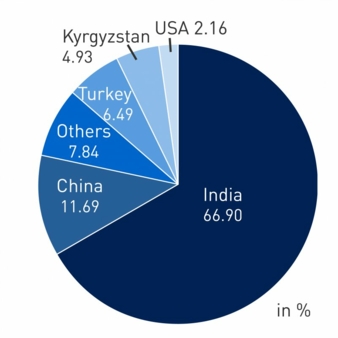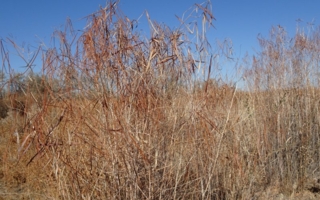12/09/2017 – Cotton — auf Deutsch lesen
GOTS Organic Cotton from India under fire
According to available information, genetically modified organisms (GMOs) have been found in samples of cotton yarns from India certified according to the Global Organic Textile Standard (GOTS).
The GOTS directives prohibit this. “We demand a prompt and conscientious investigation by GOTS of these accusations. The reputation of the organic textile industry is at stake,” said Roland Stelzer in a press release on 18 August. Mr Stelzer is Managing Partner of the South German weaving company Elmer & Zweifel, as well as producer and distributor of the GOTS and IVN-Best certified brand ‘cotonea’.
For some time already, it has been feared in industry circles that Indian products supplied as organic cotton contain GMOs due to the especially varied production structures that exist alongside one another. This, even if they are certified to GOTS.
The Swiss environmental magazine ‘Saldo’ researched in India and had GOTS-certified organic yarn samples tested in a German laboratory. The results submitted to the editorial team showed high GMO contamination. The magazine reported in detail on this in its issue 12/2017.
According to the Textile Exchange Cotton Market Report 2016, India produced 75,251 metric tonnes of organic cotton, which is 66.9 percent of the worldwide total of 112,488 MT, whereby the production volume of organic cotton fell by 13.4 percent compared to the previous year. India’s total cotton production in the 2014/15 season was 5.746 million tonnes. Organic cotton’s share of this would be around 1.1 percent.
Although cotton farmers are selling organic cotton for a higher price than conventional cotton, Roland Stelzer warns that in view of the circumstances, at some point there may be no GMO-free cotton or seed in India at all. Above all, as he estimates that the share of GMO cotton being grown in India is now well over 90 percent. This is also the reason for the big problems of organic cotton growing, which were already discussed worldwide in 2009. “At the time, it was assumed that the organic textile industry would not cut off the branch on which it was sitting and that it would henceforth monitor the production processes more closely itself. Unfortunately, nothing has come of that”, according to Roland Stelzer.
He himself sends seed and cotton from their own production in Kyrgyzstan and Uganda for GMO residue testing at the Impetus Bioscience specialist laboratory in Bremerhaven. He sees himself under obligation to adhere to the brand promises given through Cotonea in certificates and beyond and wants to provide security.
At this point it should be pointed out that the ICA Bremen, as a joint venture of the Bremen Cotton Exchange and ICA Liverpool, also offers DNA analyses for testing for genetic modification, in cooperation with Impetus Bioscience.
At the cotton trading level, Marco Bänninger, organic cotton specialist at Paul Reinhart AG in Switzerland, underlined the industry’s concerns: “It is generally known within the cotton trade that there is a high risk associated with purchasing organic cotton from India. It can happen that conventionally cultivated or even GMO cotton is offered as ‘organic’, and even has a certificate. There seem to be different loopholes depending on the motive. With this knowledge, one is well advised not to rely solely on the documents from the certificate issuers when buying organic cotton from India. For the trade, this means that knowledge of the cotton supplier and their cultivation areas is an absolute prerequisite so as not to jeopardise the credibility and the trust in organic cotton. In addition, offers of supposedly organically produced cotton should be examined closely.
In the case of organic cotton, which is offered for the same price, or only for a very marginal premium compared to conventionally grown cotton, detailed clarification should be carried out on the supplier and the origin of the cotton. Because of the well-known risks in India, we have gone over to increasingly buying organic cotton from partners where the trust base is right. This applies in our case to Tanzania”, said Bänninger.
On the part of the GOTS organisation, the growing concern has been noted. Together with several brands and retailers, they are already tackling the problems arising. This is intended to give industry and consumers transparent and clear information about the origin and production methods of their purchased products. A few days ago, GOTS published a position paper, available on its homepage, with a detailed explanation on the prevention and verifiable testing of GMO impurities in textiles made from certified organic cotton, including GOTS.
Claudia Kersten, Marketing and Finance Director at GOTS said: “In the GOTS standard, it has long been stipulated that the certification companies we have commissioned are obliged to carry out risk assessments according to pre-defined guidelines for the possible contamination of cotton by GMOs. This is ideally at an early stage before the ginning process to make sure, GMO cotton does not end up in processing stages. In addition, we ask all market participants to inform us immediately if they discover inconsistencies. This is the only way we can follow it directly.”
In the current situation, since cotton yarn samples were examined, GOTS does not consider the results presented in the cases in question to be sufficiently significant. According to GOTS, laboratories currently act upon different own, partly not public test methods. GOTS therefore wants to launch an international test study, with the help of external support. On the basis of a significantly larger number of samples and their testing on seed cotton or lint basis, it should be determined whether the results are satisfactory and whether it is really possible to identify and to quantify GMO in higher processing stages. For this purpose, a process to develop an EN/ISO-norm for GMO tests on cotton was initiated.
For more information on the GOTS position paper:
http://www.global-standard.org/de/?option=com_content&view=article&id=279:gots-position-paper-gm-cotton&catid=60:information-centre&acm=2_142
Others are:
Egypt (1.91%), Tanzania (1.91%), Burkina Faso (0.95%), Tajikistan (0.89%), Uganda (0.71%), Peru (0.49%), Mali (0.47%), Benin (0.34%), Ethiopia (0.13%), Brazil (0.02%), Israel (0.01%), Senegal (0.01%), Madagascar (0.004%), Colombia (0.001%)
Source: Textile Exchange Organic Cotton Market Report 2016




